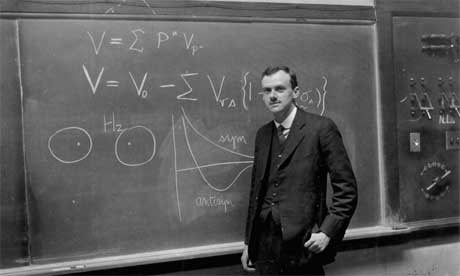
Kadison-Singer Resolved
In 2013, the Kadison-Singer problem was solved by Adam Marcus, Dan Spielman, and Nikhil Strivastava. As Dana Mackenzie said in the January/February 2014 issue of SIAM News, the Kadison-Singer problem was like a “great subterranean river of mathematics, mysteriously disappearing below the surface and reappearing where you least expect it.”
The problem appeared in different guises in mathematical physics, operator theory, complex analysis, graph theory, frame theory, signal processing, and finally as a problem in finite-dimensional geometry. In each of those areas it had a precise formulation. Interestingly, some of these formulations were believable, while others seemed quite unbelievable.
 The first formulation goes back to Paul Dirac (pictured right), who asked whether the measurements of one laboratory observable determines uniquely the observables that, by the uncertainty principle, cannot be measured at the same time. In 1958, the problem was translated into the language of operator theory by Richard Kadison and Isadore Singer, and became a statement about whether or not a “state” (a certain type of functional) defined on an abelian subalgebra of operators extends uniquely to the set of all bounded self-adjoint operators.
The first formulation goes back to Paul Dirac (pictured right), who asked whether the measurements of one laboratory observable determines uniquely the observables that, by the uncertainty principle, cannot be measured at the same time. In 1958, the problem was translated into the language of operator theory by Richard Kadison and Isadore Singer, and became a statement about whether or not a “state” (a certain type of functional) defined on an abelian subalgebra of operators extends uniquely to the set of all bounded self-adjoint operators.
The problem remained of interest mostly to operator theorists for the next twenty years, but then in 1980, a new formulation was discovered by Joel Anderson who showed that the problem was equivalent to a conjecture about the norms of submatrices of arbitrary size matrices with zero diagonals, the so-called paving conjecture. This development was significant because the new equivalence was easier to state and understand and generated activity and new attempts at a resolution. In the mean time, other conjectures in other fields were formulated, including the Bourgain-Tzafriri and Feichtinger conjectures.
In 2006, Pete Casazza, along with three other mathematicians, realized all the conjectures were equivalent. The river was again surfacing. The AIM Scientific Board suggested that the problem should be the subject of a quickly organized workshop and in 2006, Casazza, Kadison, and David Larson organized the “Kadison-Singer Problem” workshop with the goal of publicizing and explaining all the various connections.
One of the results of the workshop was one of the first AIM SQuaREs ((Structured Quartet Research Ensembles) consisting of Casazza, Bernhard Bodmann, Vern Paulsen, and Darrin Speegle. Their goal was to resolve the original conjecture or one of its equivalences, and while that was not successful, they produced a counter-example to a generalization of a 20 year old result of Bourgain and Tzafriri, which was believed to be true, resolved a 28 year old version of a paving conjecture, and proved important results in frame theory. So both the workshop and the SQuaRE provided a way to keep the Kadison-Singer river on the surface for long enough to become a problem that would capture the interest of others.
In the end, Marcus, Spielman, and Strivastava proved another equivalent version, the Weaver conjecture, which is closely related to the Anderson paving conjecture. They showed that the characteristic polynomials that are relevant to the Weaver conjecture form an interlacing family of polynomials. Coincidentally, it turns out that another AIM workshop, “Polya-Schur-Lax problems: hyperbolicity and stability preservers,” held in 2007, studied related problems. Elements of the work done by the late Julius Borcea and Peter Branden following the workshop can be seen in the solution of the Weaver conjecture.
For December 2014 a followup workshop called “Beyond Kadison-Singer: paving and consequences” is being organized by Bodman, Casazza, Marcus, and Spielman. The workshop participants will focus on the applications of the conjecture and try to discover where the river will flow next.